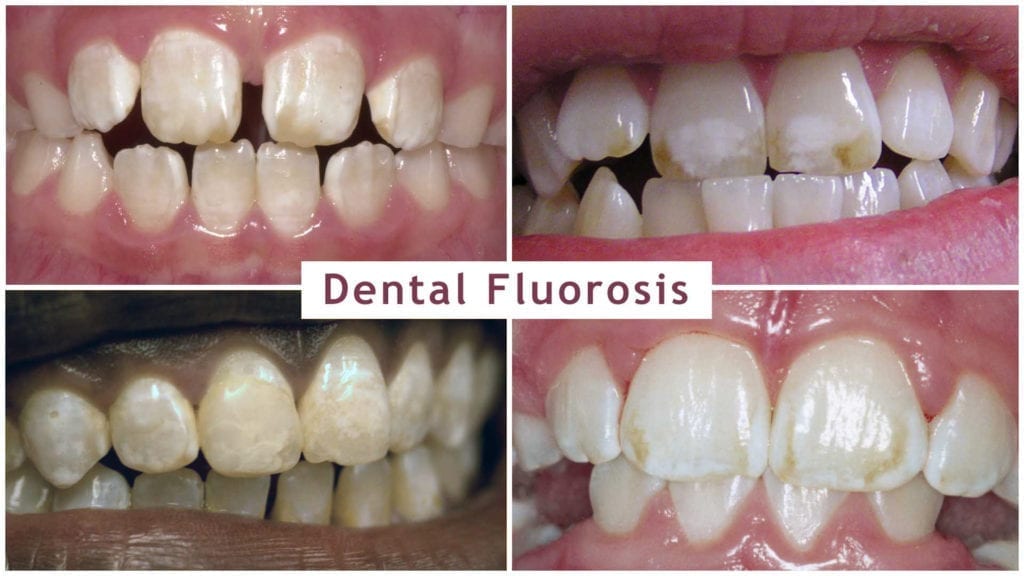Since the 1940s, an array of products containing fluoride have been introduced to the average consumer. These sources of fluoride can contribute to human health risks.
Some products that may contain added fluoride and contribute to human health risks include the following:
| Artificially fluoridated municipal water | Beverages (made with fluoridated water) |
| Dental cements with fluoride | Dental fillings with fluoride |
| Dental gels with fluoride | Dental varnishes with fluoride |
| Floss with fluoride | Fluoride drugs (“supplements”) |
| Food (that contains or has been exposed to fluoride) | Mouthwash with fluoride |
| Pesticides with fluoride | Pharmaceutical drugs with perfluorinated compounds |
| Stain resistant and waterproof items with PFCs | Toothpaste with fluoride |
Examples of Human Health Risks Associated with Fluoride

The potential health risks generated from exposure to these sources of fluoride are often overlooked. Additionally, age, gender, genetic factors, nutritional status, weight, and other factors are known to influence each person’s unique reaction to fluoride.
For example, children’s exposure to fluoride is extremely important to consider, and this issue was made evident in recent news about a study linking fluoride exposure in utero with lower IQs. As another example, fluoride was recently identified as one of 12 industrial chemicals known to cause developmental neurotoxicity in humans.
This chart includes some of the specific human health risks associated with fluoride:
| Acne and other dermatological conditions | Arterial calcification and arteriosclerosis |
| Bone weakness and risk of fractures | Cancer of the bone, osteosarcoma |
| Cardiac failure | Cardiac insufficiency |
| Cognitive deficits | Dental fluorosis |
| Diabetes | Early puberty in girls |
| Electrocardiogram abnormalities | Harm to the fetal brain |
| Hypertension | Immune system complications |
| Insomnia | Iodine deficiency |
| Lower fertility rates | Lower IQ |
| Myocardial damage | Neurotoxic effects, including ADHD |
| Osteoarthritis | Skeletal fluorosis |
| Temporomandibular joint disorder (TMJ) | Thyroid dysfunction |
Dental Fluorosis: A Warning Signal of Human Health Risks and Fluoride

Photos of Dental Fluorosis, the first sign of fluoride toxicity, ranging from very mild to severe; Photo by Dr. David Kennedy and used with permission of victims of dental fluorosis.
Exposure to excess fluoride can result in dental fluorosis, a condition in which the teeth enamel becomes irreversibly damaged. Additionally, the teeth become permanently discolored, displaying a white or brown mottling pattern and forming brittle teeth that break and stain easily.
Dental fluorosis is recognized as the first visible sign of fluoride toxicity. It is likewise a warning signal of the human health risks associated with fluoride exposure. According to 2010 data from the Centers for Disease Control and Prevention (CDC), 23% of Americans aged 6-49 and 41% of children aged 12-15 exhibit fluorosis to some degree. An assessment of the CDC’s data further demonstrates that 58% of children aged 6-19 have fluorosis.
Final Thoughts on Fluoride Exposure and Human Health Risks
Increased sources of fluoride exposure are accompanied by increased human health risks. Therefore, it has become a necessity to reduce and work toward eliminating avoidable sources of fluoride exposure, including water fluoridation, fluoride-containing dental materials, and other fluoridated products.
Fluoride Article Authors
Dr. Jack Kall, DMD, FAGD, MIAOMT, is a Fellow of the Academy of General Dentistry and a past President of the Kentucky chapter. He is an Accredited Master of the International Academy of Oral Medicine and Toxicology (IAOMT) and since 1996 has served as the Chairman of its’ Board of Directors. He also serves on the Bioregulatory Medical Institute’s (BRMI) Board of Advisors. He is a member of the Institute for Functional Medicine and American Academy for Oral Systemic Health.




